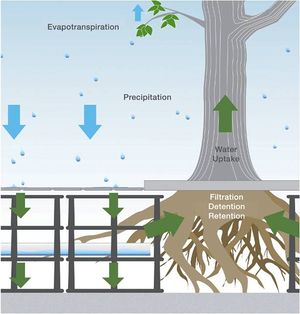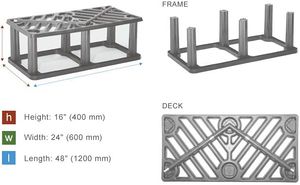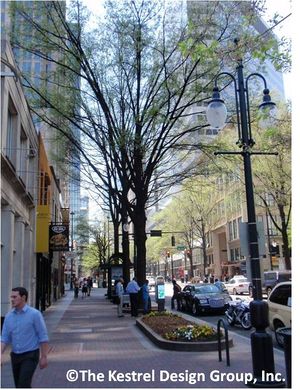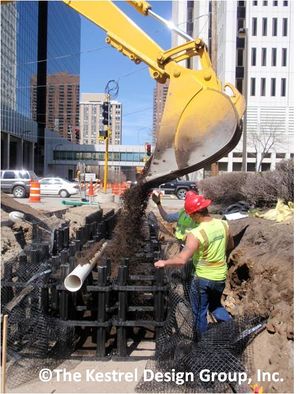
Difference between revisions of "Construction guidelines for tree trenches and tree boxes"
m |
m |
||
| Line 62: | Line 62: | ||
[[File:Streetscape planted in CU structural soil.jpg|thumb|300px|alt=Typical streetscape with tree planted in CU structural soil|<font size=3>Typical streetscape with tree planted in CU structural soil. Source:[http://www.hort.cornell.edu/uhi/ Urban Horticulture Institute, Cornell University]</font size>]] | [[File:Streetscape planted in CU structural soil.jpg|thumb|300px|alt=Typical streetscape with tree planted in CU structural soil|<font size=3>Typical streetscape with tree planted in CU structural soil. Source:[http://www.hort.cornell.edu/uhi/ Urban Horticulture Institute, Cornell University]</font size>]] | ||
| − | Rock based structural soils are engineered to be able to be compacted to 95% Proctor density without impeding root growth. | + | Rock based structural soils are engineered to be able to be compacted to 95% Proctor density [http://www.astm.org/Standards/D1557.htm][http://www.astm.org/Standards/D698] without impeding root growth. |
Rock based structural soils are typically gap graded engineered soils with the following components: | Rock based structural soils are typically gap graded engineered soils with the following components: | ||
*Stones to provide load bearing capacity and protect soil in its void spaces from compaction | *Stones to provide load bearing capacity and protect soil in its void spaces from compaction | ||
Revision as of 16:08, 12 September 2014
The anticipated construction period for this page is through September, 2014
Standard keys to success in bioretention construction apply to trees for bioretention, including the following.
- Plan for feasible temporary and permanent erosion and sediment control techniques and sequencing.
- Plan for temporary and permanent erosion and sediment control techniques, sequencing, and pay items, and prepare a thorough SWPPP plan. Example techniques include compost logs (MnDOT 2573) and plastic sheeting (MnDOT 2575), and diversion berms (MnDOT 2573).
- Plan to minimize or avoid soil compaction to the extent feasible. Techniques include, for example, using driveable mats, using tracked machinery, and machinery with long arms to avoid having to drive in tree trenches.
- Designate a stormwater supervisor to make sure someone is responsible for erosion and sediment control.
- Plan for snow storage during (if applicable) and after construction
- Construction administration and communication with contractor
- Effective communication during pre-construction meeting.
- Include “check points” in specifications with timelines – points of inspection which must be approved before proceeding to next step of construction. These will vary depending on specific project,but will include, for example, approval of required submittals, and required testing, such as, for example infiltration tests.
- Ensure checkpoints are approved prior to proceeding to next steps. Where applicable, require signature by Contractor, Designer, and Chief Inspector prior to proceeding to next step.
- Require submittals for material to be used, including, sources and certifications where applicable.
- Specify required tests and tolerances.
See the bioretention section for other construction guidelines and specifications.
Contents
Construction guidelines and specifications specifically for trees for bioretention
In addition to general bioretention guidelines and specifications, the following guidelines and specifications apply specifically to trees for stormwater design.
- Tree material and installation guidelines
- Tree soil quality and volume guidelines
- Tree opening guidelines
- Tree openings need to be large enough to allow for trunk flare. Minimum recommended tree opening dimension is 5 feet by 5 feet.
- The use of tree grates is discouraged in order to protect the tree root flare.
- Tree openings need to be protected from foot and vehicular traffic.
- Tree spacing guidelines
- For street trees, a minimum spacing of 30 feet on center is recommended for large trees to allow their canopies to grow to their full size. This also makes it easier to provide adequate soil volumes for each tree.
- Guidelines for providing rootable soil volume for tree root growth and bioretention under pavement. Where there is not enough open space for traditional bioretention, several techniques exist to protect soil volume under pavement from traffic compaction so that this soil can be used both for bioretention and tree root growth. Examples of these techniques include:
- Structural cells
- Rock based structural soil
- Sand based structural soil
- Soil boxes
Each of the above techniques is described and compared below. Links to construction guidelines are also provided.
Suspended pavement
In areas that do not have enough open space to grow large trees, techniques like suspended pavement can be used to extend tree rooting volume under HS-20 load bearing surfaces and create favorable conditions to grow large trees in urban areas. This rooting volume can also be used for bioretention. While suspended pavement has been built in several different ways, all suspended pavement is held slightly above the soil by a structure that “suspends” the pavement above the soil so that the soil is protected from the weight of the pavement and the compaction generated from its traffic.
One of the earliest examples of trees grown in suspended pavement is in Charlotte, North Carolina, where a reinforced concrete sidewalk was installed over the top of poured in place concrete columns. While this is an effective way to grow large trees, it is labor intensive and requires intensive surveying to ensure that column heights are precise.
A more recently developed, and less labor intensive technique to build suspended pavement is through the use of soil cells. An example is the Silva Cell, a modular proprietary pre-engineered structural cell manufactured by Deeproot Green Infrastructure (NOTE: Reference herein to any specific commercial products, process, or service by trade name, trademark, manufacturer, or otherwise, does not necessarily constitute or imply its endorsement, recommendation, or favoring by the Minnesota Pollution Control Agency). The modular design allows flexibility to size the rooting/bioretention volume as needed for each site. Underground utilities can be accommodated within Silva Cells systems. The Silva Cell system consists of silva cell frames that are 48 inches (1200 millimeters) long by 24 inches (600 millimeters) wide by 16 inches (400 millimeters) high. Frames can be stacked up to three high, and a deck is installed above the top frame. An air space between the top of the soil and the deck prevents tree roots in the upper soil layers from lifting the overlying pavement.
Because soil in a suspended pavement system is protected from compaction from loads on the pavement, a wide range of soils can be used in these systems, so soil can be tailored to desired functions (e.g. tree growth and stormwater management). The Silva Cell system, for example, can support vehicle loading up to AASHTO H-20 rating of 32,000 pounds (14,500 kilograms) per axle. According to Deeproot’s website “This rating refers to the ability of a roadway to safely accommodate 3 to 4 axle vehicles, such as a large semi-truck and trailer.” The cells are made of “an ultra high-strength compound of glass and polypropylene, with galvanized steel tubes to add support and prevent plastic creep.”
Construction documents and specifications for a wide range of Silva Cell applications can be found on Deeproot Green Infrastructure’s website. Many other resources are available on their website including, for example
- a summary of structural loading capacity testing;
- general cost information;
- many resources for installation, including installation instructions and a video of installation guidelines;
- case studies; and
- life cycle cost analysis.
Rock-based structural soils
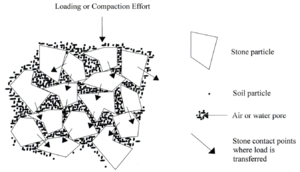
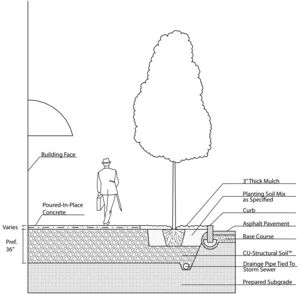
Rock based structural soils are engineered to be able to be compacted to 95% Proctor density [1][2] without impeding root growth. Rock based structural soils are typically gap graded engineered soils with the following components:
- Stones to provide load bearing capacity and protect soil in its void spaces from compaction
- Soil in rock void spaces for tree root growth
- Tackifier to keep the soil uniformly distributed in the rock void spaces (tackifier is only found in some kinds of rock based structural soil).
Stone lattice
Desired characteristics for the stone base used in rock based structural soils include the following.
- The stones should be uniformly graded and crushed or angular for maximum porosity, compaction, and structural interface (Bassuk et al 2005).
- Mean pore size should be large enough to accommodate root growth (Lindsey 1994).
- Significant crushing of stone should not occur during compaction (Lindsey 1994).
According to University of California-Davis (1994), 2 inch stones would be able to support most tree roots. Because limestone has been found to crush on some projects, granite stone is recommended.
Soil
Soil needs to have adequate nutrient and water holding capacity to provide for the tree’s needs.
Tackifier
The tackifier, if used, should be non-toxic and non-phototoxic.
Many more construction drawings are available on Cornell University’s website, including
- detail and plan for using structural soil in a planting island;
- detail and plan for using structural soil in a limited soil volume planter;
- detail for using structural soil with permeable pavers; and
- detail for structural soil breakout zone.
Types of structural soils
Several types of rock based structural soils have been developed, including
- Cornell University (CU) structural soil: 80 percent stone with size ranging from 0.75 to 1.5 inches and 20 percent loam to clay loam soil with minimum 20 percent organic matter, by dry weight, and hydrogel to uniformly mix the stone and soil (CU 2005). Patented formula available only from licensed producers to ensure quality control. Considerable information can be found on Cornell University's website.
- University of California (UC) Davis structural soil: 75 percent lava rock (0.75 inches)and 25 percent loam soil (by volume) (Xiao and McPherson 2008).
- Stalite structural soil: 80 percent Stalite, a porous expanded slate rock (0.75 inches), and 20 percent sandy clay loam soil (by volume)(Xiao and McPherson 2008).
- Swedish structural soil
Design considerations for trees growing in structural soil
Day and Dickinson (Eds., 2008) provides information on use of trees in structural soils, including design specifications. The following considerations should be made in using structural soils.
Soil pH
Care must be taken to select species tolerant of structural soil pH. For example, if limestone basedstructural soil is used, trees tolerant of alkaline pH must be selected, as limestone can raise the pH of soil to 8.0 or higher (Bassuk 2010 soil debate, Urban 2008).
Drainage Rate
Because rock based structural soils drain quickly (greater than 24 inches per hour), designers should select tree species tolerant of extremely well drained soils (Bassuk 2010).
Volume of rock based structural soil needed for healthy tree growth
Because only 20 percent of the volume of a rock based structural soil is actually soil, a greater total volume of rock based structural soil is needed compared to growing the same size tree in a sandy loam soil. A pot study by Loh et al (2003) found that 5 parts of structural soil were needed to provide the soil value of 1 part of loam soil (Loh et al, 2003). Similarly, an on-going study at Bartlett Tree labs is finding that over the past 9 years, trees growing in loam soil in suspended pavement have been consistently outgrowing trees growing in equal volumes of rock based structural soils, stalite soil, and compacted soil.
Based on the above studies, Urban (2008) recommends: “Given the extreme inefficiency of the ratio of excavated volume to soil usable by the tree, strips of structural soil less than 20 feet wide might be better constructed as soil trenches or structural cells, where more soil can be included for less cost. A 5-foot wide soil trench set of structural cells…will provide more soil usable by the tree than a 20 foot wide trench of soil/aggregate structural soil. Soil/aggregate structural soils may have applications as a transition to other options, and to add soil in places where other options may not be practical. These might include tight, contorted spaces and fills around utility lines and against foundations where full compaction is required (p. 306)”
More information about rock based structural soils is available online, for example, at
- Cornell University’s website; and
- A joint website by Cornell University’s, Virginia Tech, Rutgers University, and University of California Davis.
Sand based structural soil
Sand based structural soils were first developed in Amsterdam when some trees were in poor condition because of an “unfavorable rooting environment” (Couenberg 1993). Because the natural soils in Amsterdam, bog-peat, was non-load bearing, the top 2 meters of soil had been replaced with a medium coarse sand, which had insufficient nutritional value. Amsterdam soils were developed in an effort to grow better trees but still provide adequate bearing capacity for pavement bearing light loads, suchas sidewalks. The Dutch studied various mixes for tree growth, soil settlement, and several other parameters. The resulting Amsterdam Tree Soil contains medium coarse sand with 4 to 5 percent organic matter and 2 to 4 percent clay by weight and also meets other criteria, including, for example, (1) the medium coarse sand must meet specific gradation requirements, (2) soil mix must be free of salt, (3) mix must contain less than 2 percent particles below 2 micrometers, and (4) amount of particles below 2 micrometers must be considerably less than the amount of organic materials (Couenberg 1993).
All medium coarse sand (the layer above the Amsterdam Tree Soil) is compacted to 95 percent to 100 percent Proctor density. Amsterdam tree soil is not compacted to 100 percent density, but “is compacted until the soil has a penetration resistance between 1.5 and 2 MegaPascal (187 to 250 pounds per square inch (PSI)) ... Comparison of soil density values after filling with soil density at 100 percent Proctor Density has shown that soil density of Amsterdam Tree Soil after filling amounts to 70 to 80 percent Proctor Density” (Couenberg 1993).
Amsterdam Tree Soil was found to settle 19 millimeters [0.75 inches] in 3 years compared to the surrounding pavement, which was acceptable according to Dutch standards (Couenberg 1993), but may not be acceptable to many communities in the US to minimize risk of litigation related to trip and fall hazards.
The standard design in Amsterdam includes the following from bottom to top:
- Ground water table 1 to 1.2 meters below ground level
- Saturation zone 10 to 20 centimeters
- Layer of compacted, non-saturated sand
- Amsterdam tree soil compacted in 2 layers of 40 to 50 centimeters
- Compacted layer of 10 cm medium coarse sand for paving.
- Pavement, typically concrete pavers 30 x 30 x 5 centimeters (Couenberg 1993)
While Amsterdam sand based soils work well in Amsterdam, trees grown in Amsterdam soils in Minnesota would likely need significant irrigation, as they have low water holding capacity. Amsterdam receives an average of 36 inches of rain per year, which is higher than the range of average yearly rainfall in Minnesota. Rainfall events are also more frequent and lower intensity in Amsterdam than in Minnesota. Summer temperatures are also higher in Minnesota than in Amsterdam, resulting in higher water needs by trees. According to Couenberg (1993), who helped develop Amsterdam soils “the Amsterdam tree soil has been developed in an area where there is sufficient rainfall. If this soil is used in other climatic areas, adaptations to the tree pit will have to be made after the local situation has been monitored.”
Most of Amsterdam also has a high water table which is controlled to have almost no seasonal fluctuation, and groundwater wicks up into tree rooting zones by capillary action, so trees always have access to water from the ground water table. According to Urban (2008), “tests of Amsterdam planting soil in other locations in Europe without high water tables showed less promising results with overly dry soil, which required significant supplemental water.”So, in summary, sand based structural soils may be a viable in Minnesota if (1) some settlement is acceptable with light structural loads, and (2) trees are irrigated.
Soil boxes
Soil boxes are concrete boxes designed for bioretention. They are typically proprietary products, such as, for example, the boxes made by Filterra and Contech. Rooting volume capacity of these boxes is typically limited to large shrubs. Soil volumes provided by these boxes are typically not sufficient to grow healthy large trees. A standard 6 feet by 6 feet Filterra box, for example, provides 72 cubic feet of soil, assuming a 2 foot depth of soil. Given that the recommended soil volume for trees is 2 cubic feet of soil per 1 square foot of tree canopy, this is only enough to support a tree with a 5 foot radius canopy.
References
- Bassuk, Nina. 2010. Using CU-Structural Soil to Grow Trees Surrounded by Pavement. In The Great Soil Debate Part II: Structural soils under pavement. ASLA Annual Meeting Handout.
- Bassuk, Nina, Jason Grabosky, and Peter Trowbridge. 2005. CU-Structural Soil™ in the Urban Environment.
- Couenberg Els. A.M. 1993. Amsterdam Tree Soil. In: The Landscape Below Ground. Proceedings of an international workshop on tree root development in urban soils.
- Day, S.D, and S.B. Dickinson (Eds.) 2008. Managing Stormwater for Urban Sustainability using Trees and Structural Soils. Virginia Polytechnic Institute and State University, Blacksburg, VA.
- Grabosky, Jason, Edward Haffner, and Nina Bassuk. 2009. Plant Available Moisture in Stone-soil Media for Use Under Pavement While Allowing Urban Tree Root Growth. Arboriculture& Urban Forestry 35(5): 271-278.
- Lenth, John and Rebecca Dugopolski (Herrera Environmental Consultants), Marcus Quigley, Aaron Poresky, and Marc Leisenring (Geosyntec Consultants). 2010. Filterra® Bioretention Systems: Technical Basis for High Flow Rate Treatment and Evaluation of Stormwater Quality Performance. Prepared for Americast, Inc.
- Lindsey, Patricia, Ed. 1994. The Design of Structural Soil Mixes forTrees in Urban Areas – Part II. Growing Points 1(2). University of California.
